Flamenco in Andalusia is not just a form of entertainment—it’s the heartbeat of a culture. Born in the sun-drenched lands of southern Spain, flamenco is a deeply expressive art form that weaves together song (cante), dance (baile), and guitar (toque). Its roots lie in the diverse cultural heritage of Andalusia, influenced by Gypsy, Moorish, Jewish, and Andalusian traditions.
Experiencing flamenco in Andalusia is like stepping into a living history book—each movement and melody telling stories of love, sorrow, strength, and pride. Whether you’re attending a passionate performance in Seville or exploring a local festival in Jerez, flamenco offers an unforgettable glimpse into the soul of Spain.
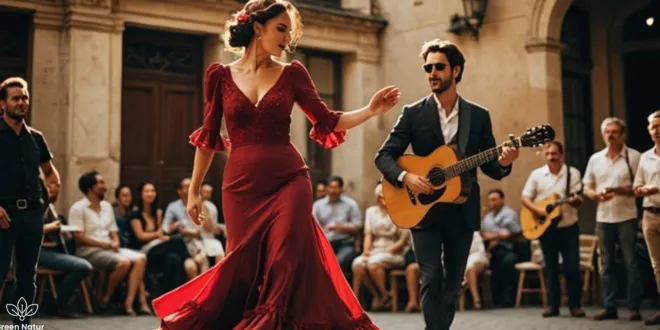
What Is Flamenco? A Cultural Symbol of Spain
Flamenco in Andalusia is much more than a dance—it’s an expression of cultural identity and passion. Originating from the southern region of Spain, flamenco blends dance, song, and guitar into an emotionally charged performance.
Deeply rooted in the history of Andalusia, flamenco has evolved through centuries of influences, including the Gypsies, Moors, and Jews. This section helps readers understand that flamenco is an art form that communicates the pain, joy, and beauty of Andalusian life, making it a powerful cultural symbol.
The History of Flamenco in Andalusia
The history of flamenco in Andalusia is complex and fascinating, shaped by the diverse cultures that have inhabited the region over centuries. From its early roots in the Andalusian countryside among the Romani people, flamenco grew to encompass various influences, including those of Jews, Moors, and indigenous Andalusians.
This section outlines how flamenco evolved from informal gatherings into a nationally recognized art form, ultimately being declared an Intangible Cultural Heritage of Humanity by UNESCO. Understanding this history gives visitors a deeper connection to the performances they will experience in Andalusia.
Flamenco Music, Dance, and Song: Key Elements Explained
At the heart of flamenco in Andalusia lies a perfect synergy between its three core elements: cante (song), baile (dance), and toque (guitar). Each of these elements carries a distinct emotional power, contributing to the intensity and beauty of a flamenco performance. The cante reflects deep emotions, often showcasing themes of longing, love, or heartbreak.
The baile, with its rhythmic footwork and expressive body movements, tells the story through powerful gestures. The toque provides the essential rhythm, adding layers of complexity to the performance. Together, these elements create an unforgettable cultural experience.
Where to Experience Authentic Flamenco in Andalusia
For travelers seeking an authentic taste of flamenco in Andalusia, the region offers a wide variety of venues that showcase true artistry. Major cities such as Seville, Jerez, and Granada are home to intimate tablaos (flamenco bars) and peñas (flamenco associations), where audiences can enjoy passionate and raw performances by local artists.
Unlike commercialized shows, these venues offer an atmosphere where flamenco is performed with genuine emotion and artistry. Knowing where to go and what to look for ensures that visitors experience flamenco at its most authentic.
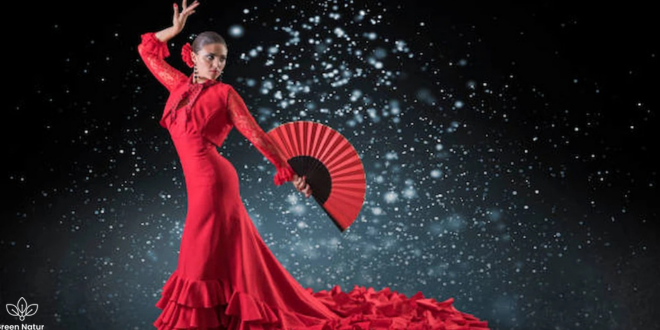
Best Cities in Andalusia for Flamenco Shows
When it comes to flamenco in Andalusia, certain cities are considered the heart of the art form. Seville, the birthplace of many flamenco legends, offers a rich variety of shows, from intimate venues to large festivals. Jerez de la Frontera is another key city, where flamenco maintains its raw and traditional style.
Granada, with its historical backdrop of the Alhambra, offers flamenco in the unique setting of cave performances in the Sacromonte district. Each of these cities provides a different flavor of flamenco, ensuring that every visitor can find their own perfect flamenco experience.
Flamenco vs. Tourist Performances: How to Spot the Real Thing
For those new to flamenco in Andalusia, it’s important to distinguish between authentic performances and those designed purely for tourists. Genuine flamenco shows are often unscripted, allowing the performers to feed off the audience’s energy, creating a unique experience each time.
Look for venues where local flamenco artists perform, rather than large, commercial theaters. Signs of authenticity include emotional expression, the lack of a set script, and the involvement of multiple art forms—song, dance, and guitar—in a spontaneous way.
Famous Flamenco Festivals in Andalusia
Flamenco in Andalusia comes alive during the region’s major flamenco festivals, where the art form reaches its peak. The Bienal de Flamenco in Seville, one of the most prestigious flamenco festivals, attracts global artists and flamenco enthusiasts.
The Festival de Jerez is another must-see, showcasing a mix of performances, workshops, and classes. These festivals not only highlight flamenco’s cultural importance but also offer visitors the chance to immerse themselves in the world of flamenco through various events, from concerts to flamenco dance classes.
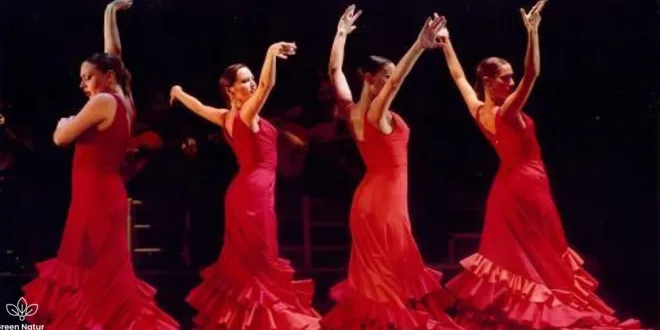
Flamenco Costumes and Instruments: Traditions and Meanings
Flamenco in Andalusia isn’t just about the performance—it’s also about the rich traditions that shape it. Flamenco costumes, such as the traje de flamenca worn by dancers, are colorful and vibrant, often symbolizing the passion and energy of the dance.
Instruments like the Spanish guitar, cajón (box drum), and castanets hold deep cultural significance, each contributing a distinct sound that shapes the rhythm of flamenco. This section offers insight into the symbolic and practical roles these costumes and instruments play in flamenco performances.
Tips for Tourists: How to Enjoy Flamenco Like a Local
To truly appreciate flamenco in Andalusia, it’s important to embrace the experience like a local. This section provides practical advice for tourists, such as arriving early to secure a good spot, respecting the artists’ emotional expressions, and avoiding overly commercialized shows.
Additionally, learning about the flamenco customs and etiquette—such as not clapping or interrupting during key moments—will enhance your experience and help you connect more deeply with the art form.
Can You Learn Flamenco While Visiting Andalusia?
For those who are eager to engage with flamenco in Andalusia beyond just watching, this section highlights opportunities to learn the art form firsthand. Many cities offer workshops and short courses in flamenco dance and guitar, where both beginners and experienced learners can immerse themselves in the rhythm of Andalusia.
Whether it’s a quick class during a short visit or a more intensive course, learning flamenco provides visitors with a deeper connection to the culture and a lasting memory of their trip.
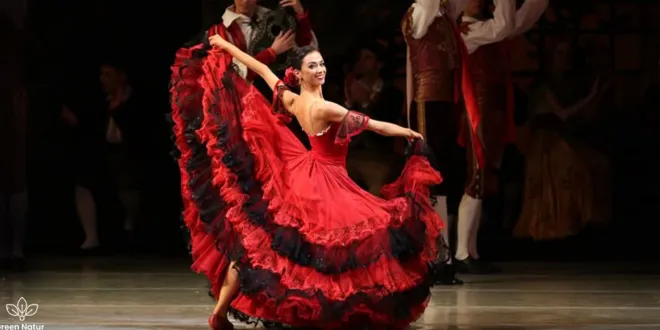
Final Word
Experiencing flamenco in Andalusia is more than watching a performance—it’s stepping into the emotional heartbeat of Spanish culture. Whether you’re drawn to the soulful music, the passionate dance, or the rich history behind it all, Andalusia offers the most authentic setting to connect with this world-renowned art form.
From local tablaos to grand festivals, every flamenco moment you witness here will leave a lasting impression. So, as you plan your journey through southern Spain, make sure flamenco isn’t just on your itinerary—it’s at the heart of it.
Frequently Asked Questions
1. Where can I see authentic flamenco in Andalusia?
You can find authentic flamenco in cities like Seville, Jerez, and Granada—especially in local tablaos and small cultural centers.
2. What is the best time of year to see flamenco in Andalusia?
Spring and early autumn are ideal, especially during major flamenco festivals like the Bienal de Flamenco or Festival de Jerez.
3. Is flamenco only performed in Seville?
No, while Seville is famous for it, flamenco in Andalusia is popular across the region, especially in Jerez, Cádiz, Córdoba, and Granada.
4. Can tourists learn flamenco while visiting Andalusia?
Yes, many studios and schools offer beginner flamenco dance and guitar classes in cities like Seville and Granada.
5. How long is a typical flamenco show?
Most flamenco performances last between 60 to 90 minutes.
6. Do I need to book flamenco tickets in advance?
For popular shows or festivals, it’s best to book in advance, especially during peak tourist seasons.
7. Is flamenco in Andalusia expensive to watch?
It varies—some venues charge €15–€40, while others offer free or low-cost performances in bars or cultural centers.
8. What should I wear to a flamenco show?
Smart casual is fine. There’s no formal dress code unless specified by the venue.

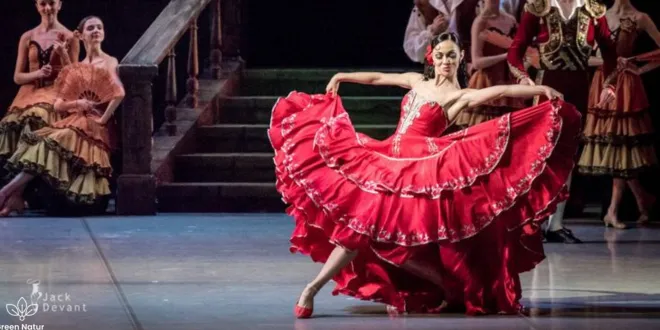
3 Comments
Glad I detected this on google .
I gotta bookmark this web site it seems very useful very useful
I simply wanted to thank you very much once again. I’m not certain what I would have achieved in the absence of the advice documented by you directly on that subject matter. It actually was a very difficult circumstance in my view, however , being able to see a skilled way you managed that forced me to jump over fulfillment. I’m happier for this service and believe you are aware of an amazing job you were doing educating people today all through a blog. I am certain you have never encountered all of us.
Your comment is awaiting moderation.
Appreciate it for helping out, fantastic info .